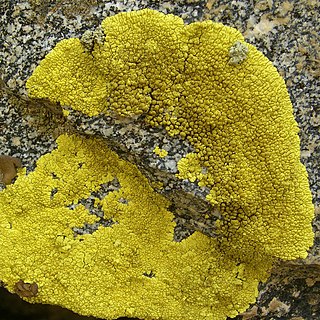Top Qs
Timeline
Chat
Perspective
Pleopsidium
Genus of lichen From Wikipedia, the free encyclopedia
Remove ads
Pleopsidium is a genus of lichen-forming fungi in the family Acarosporaceae. The widespread genus, which contains four species,[3][4] was circumscribed by lichenologist Gustav Wilhelm Körber in 1855.[5]
Remove ads
Description
Summarize
Perspective
Pleopsidium is a genus of crustose lichens, typically forming small, patchy crusts divided into separate, block-like sections (areoles). Around the edges, these lichens may develop elongated or somewhat shaped (effigurate) lobes. The upper surface can be smooth or faintly wrinkled, and is most often a bright, vibrant yellow, though some specimens appear paler and slightly greenish. Beneath this surface layer, the photosynthetic partner is a green algal cell type known as chlorococcoid algae, arranged in a continuous layer. The upper cortex—the thin protective "skin"” on top—is made of small, closely packed cells (prosoplectenchymatous), but there is no lower cortex on the underside.[6]
The reproductive structures, the apothecia, sit either on the surface or are slightly embedded. Initially they are flat, gradually becoming more dome-shaped over time. These structures are often surrounded by a distinctive thalline margin, especially in younger apothecia. The exposed centre (disc) of the apothecium varies from yellow to brownish-yellow. Inside, numerous thin, branched, and septate threads called paraphyses help support the spore-producing tissue. The asci (spore sacs) are club-shaped, contain over a hundred spores each, and have a characteristic dome at their tip. They display a blue reaction when treated with a combination of potassium (K) and iodine (I) chemicals. The spores themselves are ellipsoidal, colourless, and do not have internal divisions.[6]
In addition to sexual reproduction through spores, Pleopsidium also reproduces via tiny, flask-shaped structures called pycnidia, which are hidden within the thallus. These produce small, ellipsoidal conidia (asexual spores) that narrow slightly at one end.[6]
Chemically, Pleopsidium species contain rhizocarpic acid as well as specific fatty acids known as acaranoic and acarenoic acids. Ecologically, these lichens are typically found growing on rocks (saxicolous) in cool and humid environments, where they can often be identified by their distinctive bright yellow crusts.[6]
Remove ads
References
Wikiwand - on
Seamless Wikipedia browsing. On steroids.
Remove ads

